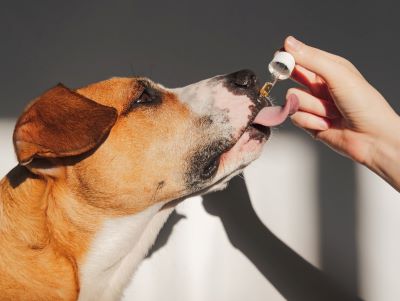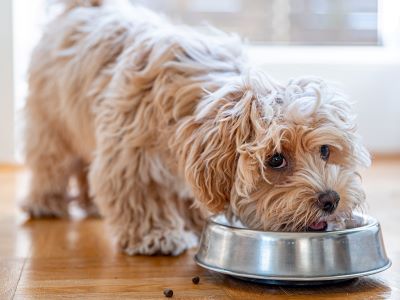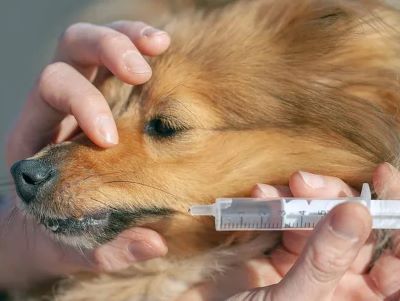Have you noticed any of the symptoms like diarrhoea, lack of appetite and weight loss in your dog? Are you worried that something is wrong with your pup? Let me help you on this.
What is Panacur for dogs? Panacur is a medicine which help dogs to get rid of worms inside their bodies. It can kill different types of worms such as hookworms, roundworms, whipworms, lungworms, and some types of tapeworms except Dipylidium tapeworms.
It can also treat Giardia. This is a tiny germ that causes the diarrheal disease giardiasis. This germ stays in intestine, and it is passed out in stools. It can stay for weeks and months outside the pet’s body.

Why Panacur Is Used?
You might question What is the role of panacur in dogs? Panacur is a brand of antiparasitic medication for dogs. For Canine species specifically, there is a brand called “Panacur C“. It contains an active ingredient called Fenbendazole which is used to treat internal parasites present in your pup and prevent the worm infections.
Fenbendazole targets the proteins that the parasites use for their survival and attaches itself to that protein. This will prevent the germ from absorbing food and generating energy, and eventually the worm will die.
This medication is effective against hookworms, whipworms, roundworms and tapeworms. Giardia worm is present in soil, food, or water that has been contaminated with faeces from infected people or animals. This drug is also useful in treatments of Giardia infection.
Generally, Fenbendazole is available as granules or as liquid suspension, which are given orally. Your vet might recommend a stool examination after 2–4 weeks to ensure if there are any parasites left in your body.
You might wonder what happens when you miss the dose of Panacur? If you miss the dose of Panacur then you should give it when you remember, but if the dose time is near to the next dose you should skip the previous dose.
It is not advisable to give mixed or two doses at the same time. And in case of overdose, you should consult a veterinary hospital immediately.

What Is the Safe Dose for Panacur ?
Every pet owner worries if the medicines that you are providing to your furry pal is safe? Panacur is considerably safe for preventing the gastrointestinal worms. But when it comes to giving your dog any medication, it is important to ask a veterinarian for the exact dose. The effective daily dose for Panacur C is 50 mg per kg (22.7 mg per pound) of body weight.
The dosage is different for different age of dogs. It is important to give this medication 3 days in a row to treat most parasites. But in case of Giardia, the dose of Panacur is 50 mg per kg orally daily with food for three to five days.
Thus, it is necessary that your pet receives all doses as recommended by your veterinarian. You can give Panacur granules to your dog by mixing each daily dose with a small amount of food.
This drug is safe for dogs and puppies who are of 6 weeks or older. The puppies should be dewormed at 6, 8, 10, and 12 weeks of age. Dogs aged 6 months or more need to be dewormed at least twice a year.
Effective range of Panacur C is 98 to 100% against the commonly occurring worms in dogs such as ascarids, hookworms, and whipworms. However, it is only 73% effective against Taenia tapeworms and ineffective against Dipylidium tapeworms.[1]

Side Effects of Panacur
Panacur generally do not show side effects, but some worms often cause allergic reaction in the dog’s body. Only 1% of dogs face side effects like vomiting and loose stools. Also, other side effects like salivation, vomiting, and diarrhoea may occur in dogs receiving this medicine.
It is important that your vet should have complete knowledge of your furry friend’s medical history. There is a possibility that due to adverse effects your dog have facial swelling, diarrhoea, itchiness, seizures, hives, vomiting, shock, pale gums, cold limbs, and coma. [2] You also might observe some worms in your pet’s stool.
Currently, there are no drug interactions of Panacur, but diarrhoea can occur as a result from digesting the worm.

FAQs
What is the best way to give a dog Panacur?
When you are giving liquid medication to your dog, gently pull the lip away from the teeth to create a pouch along the side of the mouth. It is necessary to slowly squeeze the syringe to pass the liquid Panacur. You have to do this slowly, so the dog has time to swallow the liquid and breathe. Most pooches will spit out some of the medication.
How do you know if a dog has worms?
You might observe certain signs of Worms in these furry pals including bloated belly, or you might notice your dog have “unhealthy” appearance, a dull, dry coat, excessive scooting and chewing at their bottom, and visible segments that look like grains of rice attached to the fur around their bottom or on their tail.
What are the instructions for Panacur?
If you are using a liquid dosage form, it is important to shake well before use. Generally, 1ml per 1 kg body weight should be given as a single overdose. However, If your dog weighs over 64 kg, you will need an extra 10 ml of medication for each additional 10 kg of body weight. It is preferable that you can add Panacur to your pet’s food.
Can dog worms transfer to humans?
Yes, it is likely that dog worms are transferable to humans. These infections are called zoonotic infections because they travel into the human body from animals. So, while understanding these infections, you can protect yourself, your pet and your family from such diseases.
To Sum Up
Thus, Panacur is safe for puppies, adult dogs, and pregnant dogs, but the doses may differ. It needs to be given for 3 days in a row with a small amount of food. Panacur C is the brand name for this deworming medicine for dogs.
The general dose of this medicine is 50 mg per kg of the body weight. Fenbendazole is the active ingredient which is responsible to kill the parasites present in the animal’s body. This drug is available in different formulations like granules, liquid suspensions, and paste.
References:
- Evaluation of granulated fenbendazole as a treatment for helminth infections in dogs. (1982, January 1). PubMed.
- Fenbendazole | VCA Animal Hospital |. (n.d.). Vca.



